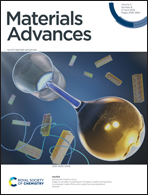Graphitization induced structural transformation of candle soot carbon into carbon nano-onion as a functional anode for metal-ion batteries†
Abstract
This work reports for the first time the structural transformation of glassy spherical candle soot carbon into graphitic polyhedral carbon nano-onions (multilayer fullerenes) by simple graphitization of candle soot carbon at varying temperatures from 1500 to 2400 °C. This structural transformation of candle soot carbon is thoroughly investigated by high-resolution transmission electron microscopy, X-ray diffraction, and Raman spectroscopy, with the aid of first-principles calculation based on density functional theory to understand the effect on physiochemical properties. Further, this understanding of structural transformation enables a promising pathway to tune the electrochemical properties of graphitized candle soot carbon to develop it as a functional anode for metal-ion (Li-ion as well K-ion) battery applications.



 Please wait while we load your content...
Please wait while we load your content...